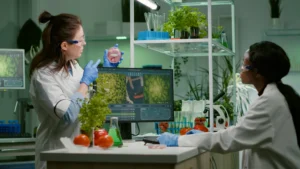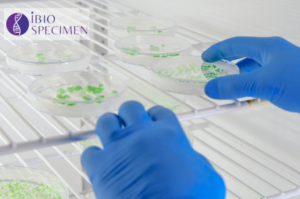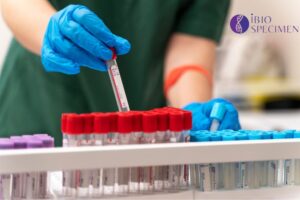- +1 (408)580-1396
- info@iBioSpecimen.com
Mastering the Art: Steps for FFPE Tissue Preparation
- August 12, 2023
Mastering the art of FFPE tissue preparation is crucial for researchers and pathologists working with formalin-fixed paraffin-embedded samples. This blog post will guide you through the essential steps, from collecting human tissue samples to quality control and storage. With attention to detail and expertise in mind, let’s dive into the precise techniques required to ensure accurate results in your FFPE tissue preparations.
Steps for FFPE Tissue Preparation
Fixation
Did you know that fixing and embedding tissue samples in formalin and paraffin wax helps preserve the cellular structures for accurate analysis?
After tissue dissection, it is crucial to fix the samples in formalin for a minimum of 24 hours. Formalin acts as a preservative and stabilizes the cellular structures within the tissue.
Embedding
To preserve the fixed tissues, they are dehydrated using a series of ethanol solutions. Once dehydrated, the tissues are embedded in paraffin wax, which provides structural support during sectioning and staining processes.
Proper Identification and Labeling
Gathering relevant patient information is the first crucial step in proper identification and labeling of tissue samples. This includes obtaining accurate details such as patient name, date of collection, and specimen type. Each sample should then be assigned a unique identifier to ensure traceability throughout the process.
Accurate labeling on containers is essential to prevent any mix-ups or confusion during analysis. It is important to clearly label containers with information such as the patient’s unique identifier, specimen type, and any additional specific requirements for preservation like formalin or ethanol. This meticulous attention to detail ensures that each sample can be easily identified and tracked throughout its journey from collection to analysis.
Tissue Dissection
Using sterile instruments is crucial during the tissue dissection process to minimize contamination. Ensure that all tools are properly sterilized before beginning the dissection. When identifying target tissue sections, it’s important to have a clear understanding of the desired areas for analysis or study. Take caution not to include any surrounding tissues or unwanted structures in order to obtain accurate results. To further prevent contamination, handle the tissue sections with clean and gloved hands throughout the entire process.
Fixation
Choosing appropriate fixatives is crucial for successful human FFPE tissue sample preparation. Formalin, a commonly used fixative, is recommended due to its ability to preserve cellular morphology and prevent autolysis. Optimization of fixation time is essential as different tissue types require varying durations for complete fixation. It is important to ensure complete immersion of tissues in the fixative solution to achieve uniformity in preservation and avoid artifacts during subsequent processing steps such as paraffin embedding.
Dehydration
To ensure successful paraffin embedding, dehydration of the tissue is a critical step in FFPE tissue preparation. Dehydration removes water from the tissue and replaces it with ethanol to prepare it for infiltration with paraffin. This process aids in preserving cellular structures and preventing damage during subsequent steps. Proper dehydration using a graded series of ethanol solutions, starting from low concentration to higher concentrations, is essential for optimal results.
Embedding
To ensure optimal preservation and stability of the tissue sample, it is crucial to embed the properly fixed and dehydrated tissue in paraffin. Paraffin embedding provides structural support and prevents distortion during sectioning. First, the tissue is placed in a cassette that allows for easy handling throughout the process. Then, it undergoes infiltration with liquid paraffin under vacuum pressure to replace any remaining ethanol or formalin within the sample. The final result is a solid block of paraffin-embedded tissue ready for FFPE storing.
Note: It seems that two topics are covered here:
1) Importance of embedding in paraffin after fixation and dehydration.
2) Steps involved in embedding including placement in a cassette, infiltration with paraffin under vacuum pressure etc.
3) Mentioned keywords – formalin, ethanol
Preparing FFPE Tissue Sections
Sectioning
To prepare FFPE tissue sections, begin by carefully sectioning the tissue into thin slices. Use a microtome to ensure precision and consistency in slice thickness.
Mounting
Once the tissue sections are obtained, transfer them onto glass slides for mounting. Ensure that the slides are clean and free from any contaminants before placing the sections onto them.
Drying
After mounting the tissue sections on glass slides, allow them to dry completely at room temperature. This ensures proper adhesion of the tissue to the slide surface.
Staining
Finally, proceed with staining the FFPE tissue sections using appropriate histological stains. Follow established protocols and best practices for optimal staining results.
Sectioning
To ensure accurate and reliable results in FFPE tissue preparation, proper sectioning techniques are crucial. Here are some key steps to follow:
- Use a sharp microtome blade for precise cuts
- Set the thickness of each section according to experimental requirements
- Clean the microtome thoroughly before starting
- Position the tissue block securely in the microtome chuck
- Adjust the cutting speed and angle for optimal results
Mounting
In this step of FFPE tissue preparation, carefully transfer the tissue sections onto slides for mounting. Use a fine-tip brush or forceps to gently lift each section and place it onto a clean slide. Ensure that the sections are positioned evenly and avoid any overlap or folding. Once all the sections have been mounted, allow them to air dry completely before proceeding to the next step.
(Optional) If preferred, you can use a mounting medium such as mounting gel or adhesive tape to secure the tissue sections onto the slides. Apply a thin, even layer of the chosen medium and carefully press down each section onto it for optimal adhesion. Avoid excessive pressure that may distort or damage the tissue.
Drying
After sectioning and mounting the tissue, the next step in FFPE tissue preparation is drying. This process involves carefully removing any excess moisture from the mounted sections to ensure optimal sample preservation. Proper drying techniques, such as air-drying or using a slide warmer, can help prevent artifacts and improve staining results. It is crucial to monitor the drying time closely and avoid excessive heat that could damage the tissue samples.
Staining
- Choose an appropriate staining method based on the specific tissue and desired outcome.
- Prepare the staining solution according to the manufacturer’s instructions.
- Gently immerse the mounted tissue sections into the staining solution, ensuring complete coverage.
- Incubate for the recommended time period to allow optimal stain penetration and binding.
- Rinse the stained slides with distilled water to remove excess stain and prevent artifacts.
As an expert in FFPE tissue preparation, it is crucial to master every step of the process. Staining plays a vital role in visualizing cellular structures and biomarkers within tissues. By carefully selecting a suitable stain and following proper incubation times, you can ensure accurate results that contribute to meaningful research or diagnosis.
Quality Control and Storage
Archiving and Storage
After microscopic examination, proper archiving and storage of FFPE tissue samples is crucial to maintain their integrity for future analysis. To ensure the longevity of the samples, it is essential to store them in a controlled environment with stable temperature and humidity levels. The use of archival-grade containers that are resistant to degradation from chemicals or UV exposure is recommended. Additionally, meticulous labeling and organization should be employed to facilitate easy retrieval when needed.
Recordkeeping
Accurate recordkeeping plays a vital role in maintaining quality control throughout the FFPE tissue preparation process. Detailed documentation should include information such as patient identification, sample collection date, fixation duration, and any additional pertinent information. This comprehensive record allows for traceability and aids in troubleshooting potential issues later on. An electronic database may also be utilized for efficient data management and retrieval purposes while ensuring data security through appropriate access controls.
Microscopic Examination
Gross examination of FFPE tissue samples allows for initial identification and selection of representative sections for analysis. This step ensures that the chosen sections accurately reflect the characteristics of the entire sample, maximizing the relevance and reliability of subsequent analyses. Additionally, during this examination, an assessment is made regarding tissue integrity and adequacy for downstream applications, ensuring that only high-quality specimens are used in further steps of FFPE tissue preparation.
Archiving and Storage
Proper labeling and identification of FFPE blocks are essential for effective archiving and storage. Clear and accurate labeling ensures easy retrieval of samples whenever needed. Additionally, it is crucial to maintain appropriate storage conditions to preserve sample integrity over time. This includes controlling temperature, humidity, and exposure to light.
Consideration should also be given to long-term preservation methods like cryopreservation. Cryopreservation involves freezing the tissue samples at ultra-low temperatures, which can help retain their molecular structure for extended periods. By implementing these measures in archiving and storage practices, researchers can ensure the longevity of their FFPE samples for future analysis.
Key Points:
- Labeling: Properly label FFPE blocks for easy retrieval.
- Storage Conditions: Control temperature, humidity, and light exposure during sample storage.
- Long-term Preservation: Explore cryopreservation as a method for maintaining sample integrity over time.
Recordkeeping
Accurate documentation of sample information, including patient data, is crucial in the process of FFPE tissue preparation. This ensures traceability and allows for comprehensive analysis in future studies. To facilitate this, maintaining a well-organized database plays a vital role as it enables easy retrieval and tracking of samples when needed. Establishing standardized protocols further promotes consistent recordkeeping practices, reducing errors and ensuring reliable data interpretation down the line.



